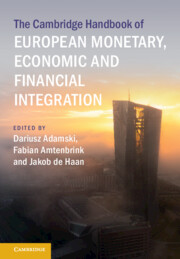Book contents
- The Cambridge Handbook of European Monetary, Economic and Financial Integration
- The Cambridge Handbook of European Monetary, Economic and Financial Integration
- Copyright page
- Contents
- Contributors
- Introduction
- Part I The Economic and Monetary Union
- Part II The Monetary Dimension
- 9 The Overburdened Monetary Policy Mandate of the ECB
- 10 Government Bond Buying by the European Central Bank
- 11 ECB Monetary Policies
- 12 From Market to Green Economics
- 13 The Politics of Monetary Union and the Democratic Legitimacy of the ECB as a Strategic Actor
- 14 How Can Courts Contribute to Accountability in EU Monetary Policy?
- Part III The Economic and Fiscal Dimensions
- Part IV Financial Integration
- Index
- References
12 - From Market to Green Economics
Impact on Monetary and Financial Policies
from Part II - The Monetary Dimension
Published online by Cambridge University Press: 28 September 2023
- The Cambridge Handbook of European Monetary, Economic and Financial Integration
- The Cambridge Handbook of European Monetary, Economic and Financial Integration
- Copyright page
- Contents
- Contributors
- Introduction
- Part I The Economic and Monetary Union
- Part II The Monetary Dimension
- 9 The Overburdened Monetary Policy Mandate of the ECB
- 10 Government Bond Buying by the European Central Bank
- 11 ECB Monetary Policies
- 12 From Market to Green Economics
- 13 The Politics of Monetary Union and the Democratic Legitimacy of the ECB as a Strategic Actor
- 14 How Can Courts Contribute to Accountability in EU Monetary Policy?
- Part III The Economic and Fiscal Dimensions
- Part IV Financial Integration
- Index
- References
Summary
The ECB has already taken the step from ‘a monetary policy rule’ towards a broad central bank with monetary and financial tasks. The next step is to green these monetary and financial stability tasks. This chapter argues that a change from the prevailing ‘market economics’ paradigm to a ‘green economics’ paradigm will make this transformation effective. Sustainability challenges are complex in nature and have a long horizon. On the financial side, the ECB should ‘de-risk the financial system’ by greening its financial stability and supervision tasks. The chapter provides an overview of the new financial instruments and their application by the ECB. On the monetary side, the ECB is still adopting a two-pronged strategy: a risk approach and an allocational approach. While the risk approach fits within market economics thinking, the green economics paradigm suggests an allocational approach whereby the ECB moves from high-carbon to low-carbon assets in its monetary policy operations. The allocational approach is gaining ground.
- Type
- Chapter
- Information
- Publisher: Cambridge University PressPrint publication year: 2023



